spare tire HONDA ACCORD COUPE 2001 CF / 6.G Owners Manual
[x] Cancel search | Manufacturer: HONDA, Model Year: 2001, Model line: ACCORD COUPE, Model: HONDA ACCORD COUPE 2001 CF / 6.GPages: 372, PDF Size: 6.1 MB
Page 209 of 372

Traction Control System
On LX V6 and EX V6 models
Your Honda is equipped with a
Traction Control System (TCS) to assist you in maintaining traction
while driving slowly on loose or slippery surfaces. The TCS assists
only in low-speed, low-traction
conditions; up to approximately 18
mph (30km/h).
The TCS monitors the speed of all four wheels. When it senses a front
wheel losing traction, it applies braking to that wheel. The TCSindicator flashes when this occurs.
Driving with TCS requires no specialskills or technique. The TCS does
not control your vehicle's whole
braking system and cannot prevent skidding if you enter a corner too
fast. It is still your responsibility to
drive at reasonable speeds and to
leave a sufficient margin of safety. When starting out or driving at low
speeds on a loose or slippery road
surface, you may notice that the
vehicle does not respond to the accelerator in the same way it does
at other times. This is a sign the TCS
is activating. You will see the TCS
indicator light flash. You should still install winter tires on
your vehicle during the winter. Make
sure to use the same size originally
supplied with vehicle. Exercise the
same caution in winter driving as you
would if your vehicle was not equipped with TCS.
Driving with the compact spare tire
installed (see page 296) may activate the TCS. You should turn off
the system.
If the brakes overheat while the TCS
is activating, the TCS indicator willstop flashing and stay on temporarily.
This indicates that the TCS system has turned off. After the brakes have
cooled down (usually for about 10
minutes), the TCS will turn back onand the indicator will turn off.
Driving
TCS INDICATOR
Page 218 of 372

Towing a Trailer
Additional Trailer Equipment Many states and Canadian provinces
require special outside mirrors when
towing a trailer. Even if they don't,
you should install special mirrors if
you cannot clearly see behind you, or if the trailer creates a blind spot.
Ask your trailer sales or rental agency if any other items are
recommended or required for your
towing situation. Pre-Tow Checklist
When preparing to tow, and before driving away, be sure to check the
following: The vehicle has been properly
serviced, and the tires, brakes,
suspension, and cooling system
are in good operating condition. All weights and loads are within
limits (see pages 211 and 212). The hitch, safety chain, and any
other attachments are secure. All items on and in the trailer are
properly secured and cannot shift
while you drive. The lights and brakes on your
vehicle and the trailer are workingproperly. Your vehicle tires and spare are
properly inflated (see page 269),and the trailer tires and spare are
inflated as recommended by the
trailer maker.
Driving
Page 271 of 372

Tires
Inflation
Keeping the tires properly inflated
provides the best combination of
handling, tread life and riding comfort. Underinflated tires wear
unevenly, adversely affect handling
and fuel economy, and are more
likely to fail from being overheated. Overinflated tires can make your car
ride more harshly, are more prone to damage from road hazards, and wear
unevenly.
We recommend that you visually check your tires every day. If you
think a tire might be low, check it immediately with a tire gauge. Use a gauge to measure the air
pressure at least once a month. Even
tires that are in good condition may
lose one to two psi (10 to 20 kPa, 0.1
to 0.2 kgf/cm2) per month. Remember to check the spare tire at
the same time you check all theother tires.
Check the pressure in the tires when
they are cold. This means the car
has been parked for at least three
hours. If you have to drive the car
before checking the tire pressure, the tires can still be considered"cold" if you drive less than 1 mile (1.6 km). If you check the pressure when the
tires are hot (the car has been driven several miles), you will see readings
4 to 6 psi (30 to 40 kPa, 0.3 to 0.4
kgf/cm2) higher than the cold
reading. This is normal. Do not let air out to match the specified cold
pressure. The tire will be
underinflated.
You should get your own tire pressure gauge and use it whenever
you check your tire pressures. This will make it easier for you to tell if apressure loss is due to a tire problem
and not due to a variation between
gauges.
Maintenance
Page 272 of 372

Tires
Recommended Tire Pressures for
Normal Driving
The following chart shows the recommended cold tire pressures for
most normal driving conditions andspeeds. Tire pressures for high
speed driving are the same as for
normal driving. The compact spare tire pressure is:
60 psi (420 kPa , 4.2 kgf/cm
2
)
These pressures are also given on
the tire information label on the driver's doorjamb. Tubeless tires have some ability to
self-seal if they are punctured.
However, because leakage is often
very slow, you should look closely for punctures if a tire starts losing
pressure.
Maintenance
Page 298 of 372

Taking Care of the Unexpected
This section covers the more- common problems that motoristsexperience with their vehicles. It
gives you information about how to safely evaluate the problem and what
to do to correct it. If the problem has
stranded you on the side of the road,
you may be able to get going again. If not, you will also find instructions
on getting your car towed. Compact Spare Tire....................... 296
Changing a Flat Tire ..................... 297
If Your Engine Won't Start........... 302 Nothing Happens or theStarter Motor OperatesVery Slowly............................. 303
The Starter Operates Normally................................. 304
Jump Starting................................. 304 If Your Engine Overheats............. 307
Low Oil Pressure Indicator.......... 309Charging System Indicator........... 310
Malfunction Indicator Lamp ........ 311 Readiness Codes........................ 312
Brake System Indicator................ 313 Closing the Moonroof................... 314
Fuses............................................... 315 Checking and Replacing........... 316
Emergency Towing....................... 320
Taking Care of the Unexpected
Page 299 of 372
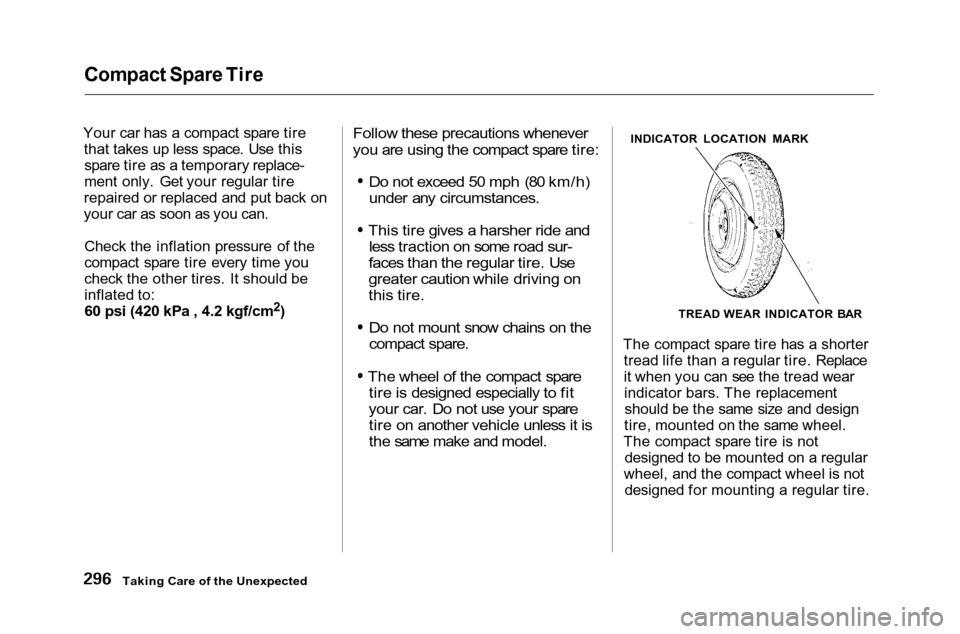
Compact Spare Tire
Your car has a compact spare tire that takes up less space. Use thisspare tire as a temporary replace-
ment only. Get your regular tire
repaired or replaced and put back on
your car as soon as you can.
Check the inflation pressure of the
compact spare tire every time you
check the other tires. It should be
inflated to:
60 psi (420 kPa , 4.2 kgf/cm 2
)
Follow these precautions whenever
you are using the compact spare tire:
Do not exceed 50 mph (80 km/h)
under any circumstances.
This tire gives a harsher ride and less traction on some road sur-
faces than the regular tire. Use
greater caution while driving on
this tire.
Do not mount snow chains on the
compact spare.
The wheel of the compact spare tire is designed especially to fit
your car. Do not use your spare tire on another vehicle unless it is
the same make and model.
INDICATOR LOCATION MARK
The compact spare tire has a shorter tread life than a regular tire. Replace
it when you can see the tread wearindicator bars. The replacementshould be the same size and design
tire, mounted on the same wheel.
The compact spare tire is not designed to be mounted on a regular
wheel, and the compact wheel is not designed for mounting a regular tire.
Taking Care of the Unexpected
TREAD WEAR INDICATOR BAR
Page 300 of 372
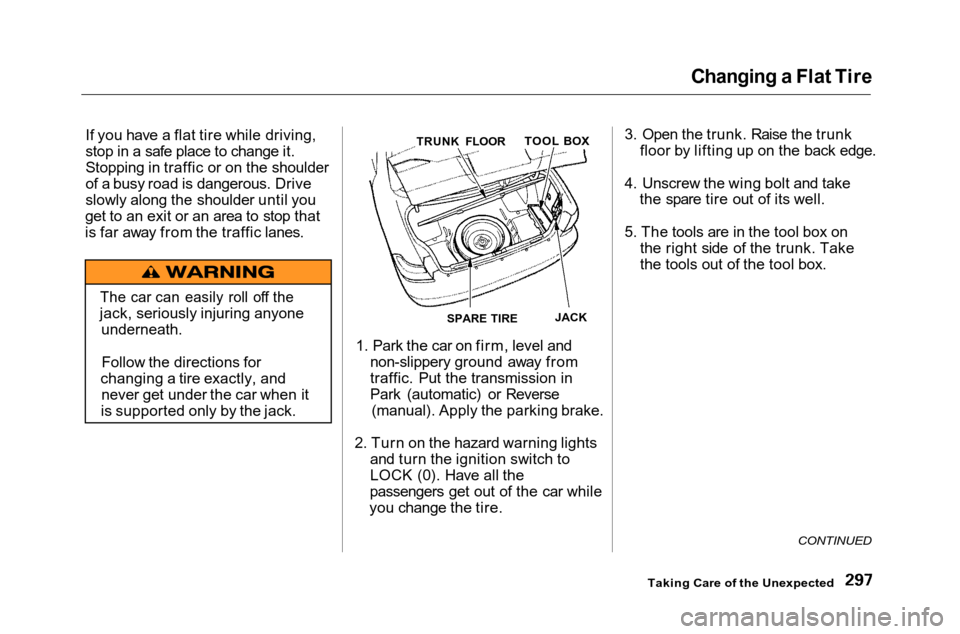
Changing a Flat Tire
If you have a flat tire while driving,
stop in a safe place to change it.
Stopping in traffic or on the shoulder
of a busy road is dangerous. Drive
slowly along the shoulder until you
get to an exit or an area to stop that
is far away from the traffic lanes.
1. Park the car on firm, level andnon-slippery ground away from
traffic. Put the transmission in
Park (automatic) or Reverse(manual). Apply the parking brake.
2. Turn on the hazard warning lights and turn the ignition switch to
LOCK (0). Have all the
passengers get out of the car while
you change the tire. 3. Open the trunk. Raise the trunk
floor by lifting up on the back edge.
4. Unscrew the wing bolt and take the spare tire out of its well.
5. The tools are in the tool box on the right side of the trunk. Take
the tools out of the tool box.
CONTINUED
Taking Care of the Unexpected
The car can easily roll off the
jack, seriously injuring anyone underneath.
Follow the directions for
changing a tire exactly, and never get under the car when it
is supported only by the jack. TRUNK FLOOR
TOOL BOX
SPARE TIRE JACK
Page 303 of 372
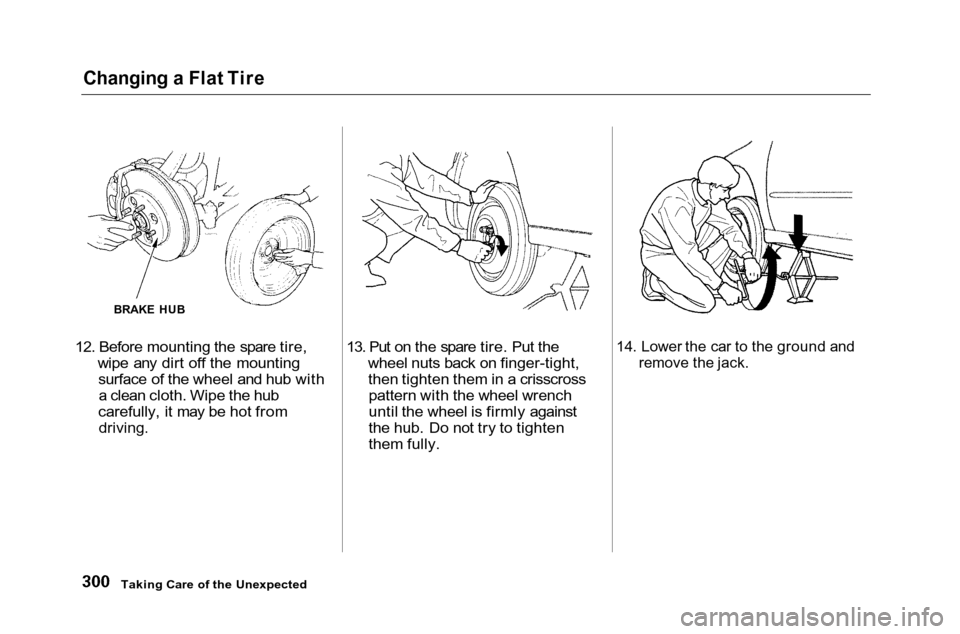
Changing a Flat Tire
12. Before mounting the spare tire, wipe any dirt off the mountingsurface of the wheel and hub witha clean cloth. Wipe the hub
carefully, it may be hot from
driving.
13. Put on the spare tire. Put the
wheel nuts back on finger-tight,then tighten them in a crisscrosspattern with the wheel wrench
until the wheel is firmly against
the hub. Do not try to tighten
them fully.
14. Lower the car to the ground and
remove the jack.
Taking Care of the Unexpected
BRAKE HUB
Page 305 of 372
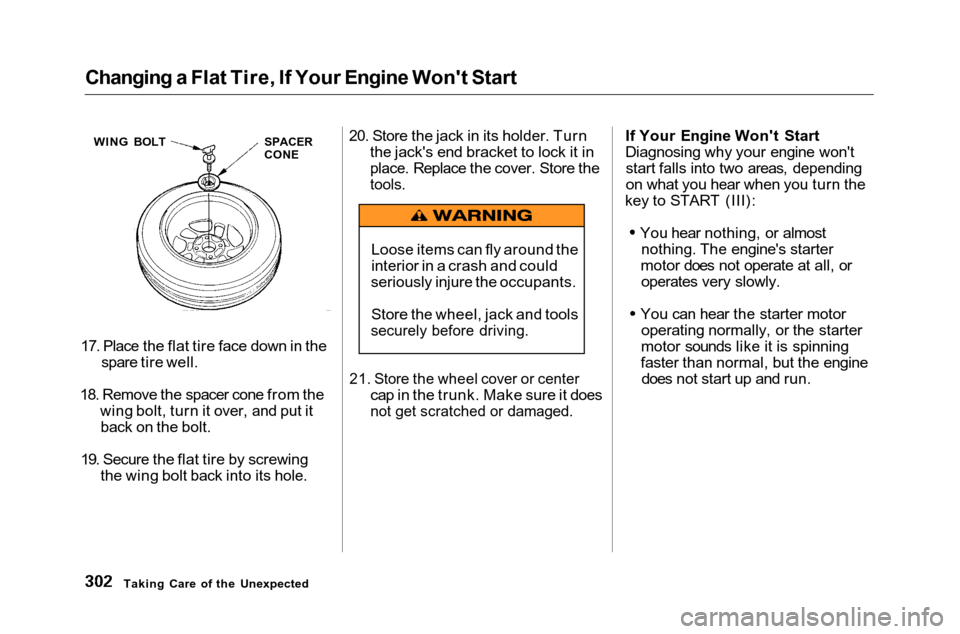
Changing a Flat Tire, If Your Engine Won't Start
17. Place the flat tire face down in the spare tire well.
18. Remove the spacer cone from the wing bolt, turn it over, and put itback on the bolt.
19. Secure the flat tire by screwing the wing bolt back into its hole. 20. Store the jack in its holder. Turn
the jack's end bracket to lock it in
place. Replace the cover. Store the
tools.
21. Store the wheel cover or center
cap in the trunk. Make sure it does
not get scratched or damaged.
If Your Engine Won't Start
Diagnosing why your engine won't
start falls into two areas, depending
on what you hear when you turn the
key to START (III):
You hear nothing, or almostnothing. The engine's starter
motor does not operate at all, or operates very slowly.
You can hear the starter motor operating normally, or the starter
motor sounds like it is spinning
faster than normal, but the engine does not start up and run.
Taking Care of the Unexpected Loose items can fly around the
interior in a crash and could
seriously injure the occupants.
Store the wheel, jack and tools
securely before driving.
WING BOLT
SPACER
CONE
Page 351 of 372
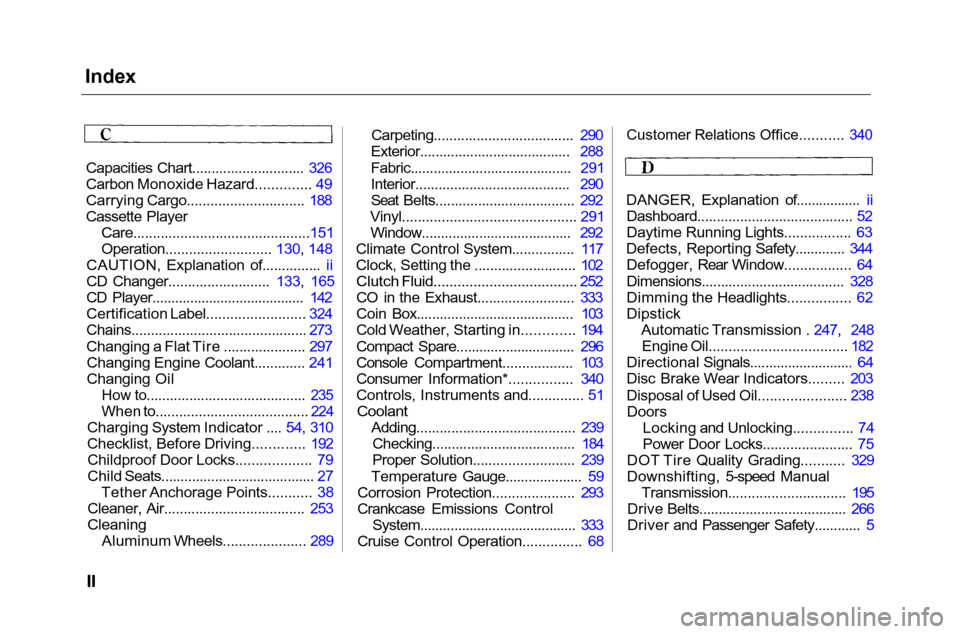
Index
Capacities Chart............................. 326
Carbon Monoxide Hazard.............. 49
Carrying Cargo.............................. 188
Cassette Player
Care.............................................151
Operation........................... 130, 148
CAUTION, Explanation of............... ii
CD Changer.......................... 133, 165
CD Player........................................ 142
Certification Label......................... 324
Chains............................................. 273
Changing a Flat Tire ..................... 297 Changing Engine Coolant.............
241
Changing Oil
How to......................................... 235
When to....................................... 224
Charging System Indicator .... 54, 310
Checklist, Before Driving............. 192 Childproof Door Locks................... 79
Child Seats........................................ 27 Tether Anchorage Points........... 38
Cleaner, Air.................................... 253
Cleaning
Aluminum Wheels..................... 289 Carpeting.................................... 290
Exterior....................................... 288
Fabric.......................................... 291
Interior........................................ 290
Seat Belts.................................... 292
Vinyl............................................ 291 Window....................................... 292
Climate Control System................ 117
Clock, Setting the .......................... 102
Clutch Fluid.................................... 252
CO in the Exhaust......................... 333
Coin Box......................................... 103
Cold Weather, Starting in............. 194
Compact Spare............................... 296
Console Compartment.................. 103
Consumer Information*................ 340
Controls, Instruments and..............
51
Coolant
Adding......................................... 239Checking..................................... 184
Proper Solution.......................... 239
Temperature Gauge.................... 59
Corrosion Protection..................... 293
Crankcase Emissions Control System......................................... 333
Cruise Control Operation............... 68
Customer Relations Office........... 340
DANGER, Explanation of................. ii Dashboard........................................ 52
Daytime Running Lights................. 63
Defects, Reporting Safety............. 344 Defogger, Rear Window................. 64
Dimensions..................................... 328
Dimming the Headlights................ 62
Dipstick Automatic Transmission . 247, 248
Engine Oil................................... 182
Directional Signals........................... 64
Disc Brake Wear Indicators......... 203
Disposal of Used Oil...................... 238 Doors Locking and Unlocking............... 74
Power Door Locks....................... 75
DOT Tire Quality Grading........... 329
Downshifting, 5-speed Manual Transmission.............................. 195
Drive Belts...................................... 266
Driver and Passenger Safety............ 5